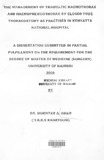| dc.contributor.author | Mukhtar, S O | |
| dc.date.accessioned | 2013-05-23T07:32:44Z | |
| dc.date.available | 2013-05-23T07:32:44Z | |
| dc.date.issued | 2005 | |
| dc.identifier.citation | M.Med (Surgery) Thesis | en |
| dc.identifier.uri | http://erepository.uonbi.ac.ke:8080/xmlui/handle/11295/24643 | |
| dc.description | Master of Medicine Thesis | en |
| dc.description.abstract | This is a prospective study conducted between tenth of February and tenth of
ovember 2004. A total of ninety-five patients with posttraumatic pleural collections
with pncumothoraxancl/ or haemothorax were recruited. Ninety-six chest tubes were
inserted in ninety-two patients. I~ighty-eight had unilateral chest tubes while the
remaining 4 had bilateral chest tubes. Three patients were managed conservatively.
Eighty seven percent of the patients were males and nearly 70% were in the 20-40
yearsage bracket. It was found that patients in slum areas were at higher risk for
penetrating injuries compared to non-slum dwellers. SixtY'one percent of the patients
I
presented with penetrating injuries the majority of which were as a result of stab
wounds. Two thirds of blunt injuries were due to RTA.
Nearly all the patients had chest radiographs performed prior to insertion of a chest
tube. The commonest pleural collection was haemopneumothorax(48.4%), which if
combined with simple haemothorax account for 72.6%. Only three different sizes of
chest tubes were utilizeJ-FG20, 24, 28-with PG-28 been the commonest tube used
(57%).All tube insertions were carried out in the triangle of safety with the fifth
intercostal space used in 52% of the patients. Sixty patients (62.5%) had their chest
tube removed within one week. Only six patients had their tubes maintained for
fifteen days or more. Two-third of patients with hacmothorax had an output of
750mls or less in the first twenty-four hours.
The study showed that 54% of the patients had their tubes removed on the basis of
chest radiographs. There was no significant difference on the outcome between the
patients who had their tubes removed on the basis of clinical examination or chest
radiographs.
Thecommonest complication encountered was empyema thoracis (8.4%). Empyema
was highlyassociated with knife stabs and longer period of chest tube left in situ.
Mortalitywas due to the initial injury and was commoner among patients withRTA
andgunshot injuries, | en |
| dc.description.sponsorship | University of Nairobi | en |
| dc.language.iso | en | en |
| dc.title | The management of traumatic haemothorax and haemopneumothorax by closed tube thoracostomy as practised in Kenyatta National Hospital | en |
| dc.type | Thesis | en |
| dc.description.department | a
Department of Psychiatry, University of Nairobi, ; bDepartment of Mental Health, School of Medicine,
Moi University, Eldoret, Kenya | |
| local.publisher | Department of Medicine, University of Nairobi | en |

